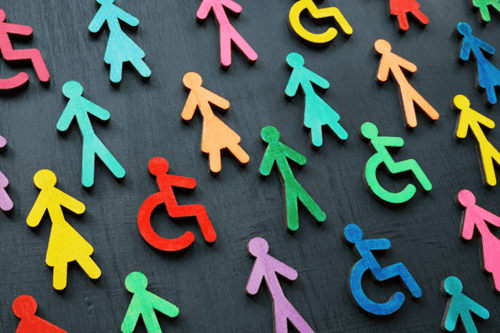As an employer, you need to understand disability discrimination. Whether you employ disabled staff members or not, you have rights and responsibilities under discrimination law which is covered by the Equality Act 2010.
Getting your treatment of staff with a physical or mental impairment right is essential. Whether that's with current staff or job applicants, this will ensure you avoid claims of discrimination arising from disability, which would result in a potentially costly employment tribunal.
Disability is a protected characteristic, and no disabled person should be treated differently in your business. If you need specific help with adapting your workplace to accommodate a disability, Croner can help. Croner has been helping businesses for over 80 years and has a team of dedicated experts on hand to advise on any HR or employment law issue. Contact Croner today on 0800 470 2589.

What is classed as discrimination?
The Equality Act 2010 protects individuals from unlawful discrimination. This piece of equal opportunities and anti-discrimination legislation protects people based on a number of protected characteristics.
That doesn't mean, however, that your organisation doesn't need to remain extremely vigilant. Discrimination arises when an employee is treated unfairly or an employer decides to give less favourable treatment to someone based on protected characteristics.
As an employer, it’s your job to encourage equality, stamp out discrimination and act decisively when it occurs.
Your responsibility as an employer is to:
- Help eliminate sex and gender discrimination.
- Race Discrimination
- Tackle sexual orientation prejudice.
- Fight religious discrimination.
- ethnic origin discrimination.
- Ensure equality for disabled employees and prevent discrimination against physically disabled employees.
- Promote inclusivity for those who have undergone, or are in the process of gender reassignment.
- Remove age discrimination from your workplace.
- Protect those who are unfairly treated following marriage or pregnancy.
In any organisation, there can be instances of both direct and indirect discrimination. Your business should therefore make sure you adhere to your employer's duty of care to your staff.
What is disability discrimination?
Disability discrimination can be difficult to spot. It may involve nicknames or seeing employees treated badly in an offensive environment. It may be that your workplace itself isn't adapted correctly. For example, poor wheelchair access or lack of accessibility for those with a visual impairment.
Types of disability-related discrimination
There are a number of types of disability discrimination. These include:
- Direct or indirect discrimination.
- Discrimination arising from disability (this includes discrimination against mentally disabled employees).
- Failure to make reasonable adjustments.
- Harassment.
- Victimisation.
There are different rights under discrimination law, depending on which of those is taking place.
How do I spot a disability?
The way an employer treats members of staff is crucial to avoid an employment tribunal. You must treat all staff fairly, not placing anyone at a substantial disadvantage.
Disability itself can sometimes be hard to spot. For example, an employee may have an undeclared learning disability or certain mental health conditions that don't impact their performance.
Disability discrimination is not about a particular disability. You must make reasonable adjustments if your employees have:
- Learning disabilities.
- Severe disfigurement.
- Mobility difficulties.
- Hearing impairment.
- A mental health condition.
- Multiple sclerosis, cancer and HIV.
- Visual impaired (possibly requiring an assistance dog).
This list is not exhaustive. As an employer, you should ensure that any job applicant is properly screened for any existing medical condition to ensure that discrimination arising from disability is avoided.
The Equality Act considers a disability to be a physical or mental condition that has a substantial and long-term negative effect on how a person goes about their everyday life—this includes some of the basics of work, such as sitting in a chair or using a computer.

How should I handle disability discrimination?
Employers must have clear policies and documentation to guard against disability discrimination. There are six different ways in which an employee can claim to have suffered discrimination arising from a particular disability.
If an employee were found to have discriminated against a disabled person, this could be an instance of gross misconduct. Likewise, if your business is found to have failed to make reasonable adjustments to accommodate a disabled person then you may find yourself at an employment tribunal.
Consideration of disability discrimination begins during the recruitment process and extends to your working practices during the employee's employment.
Direct disability discrimination
Direct disability discrimination occurs when an employee is treated unfavourably by you or your staff because of their disability. This could occur in a job interview and during the recruitment process, so be aware that discrimination claims can arise even if you are only a prospective employer.
An example of direct disability discrimination would be when an employer decides to overlook a disabled person for a promotion or pay rise opportunity because of their disability. Similarly, disability discrimination could occur if you refuse to sign off on reasonable adjustments to your workplace, such as wheelchair ramps.
What the Equality Act says about disability discrimination

Disability Discrimination Legislation
The Equality Act 2010 doesn’t apply to Northern Ireland for disability discrimination cases—only England, Wales, and Scotland. Northern Ireland still uses the Disability Discrimination Act 1995.
The Equality Act considers a disability to be a physical or mental condition that has a substantial and long-term negative effect on how a person goes about their everyday life—this includes some of the basics of work, such as sitting in a chair or using a computer.
Conditions like cancer, HIV, and multiple sclerosis are automatically disabilities.
The law also protects people from their past disabilities. If you used to have cancer, for example, you remain under protection from disability discrimination that targets this condition.
The Six Types of Discrimination Against Disabled Employees
Make sure that your policy on discrimination at work covers all of these.
While some employees might know two or three examples of disability discrimination at work, they won’t always be aware of all the different ways in which an employee can suffer discrimination because of a disability.
1. Direct Discrimination
This is when you treat an employee less favourably than you would treat others because of your employee’s disability.
An example of this would be if you chose to not consider a disabled employee for a promotion opportunity due to their disability.
2. Indirect Discrimination
This happens when you apply a practice, rule, or policy in your workplace that applies to all staff in the same way, but negatively affects one or groups of staff because of their disability.
Let’s say you wanted employees to work across two offices, and you made a rule that all staff must have a driving licence so that they can get to and from each office. This would be indirect disability discrimination against anyone who can’t or doesn’t drive or have a driving licence because of a disability.
However, if you can justify your reason for activating a rule, policy, or practice that is indirect disability discrimination as a genuine necessity, you will not be at fault.
3. Harassment
This is when you make an employee feel intimidated or shamed, or when you violate their dignity—because of their disability.
4. Victimisation
This is where you treat an employee worse than others because they’ve made a complaint of disability discrimination, or because they’re supporting somebody else who has.
5. Failure to Make Reasonable Adjustments
This is when you don’t make “reasonable” changes in your workplace to help disabled employees go about their work.
Examples include things like adapting a workstation or providing a disabled parking spot.

6. Discrimination Arising From A Disability
This happens when you treat an employee in an unfavourable way because of something caused by their disability.
For example, their disability might require them to take more absences from work to attend medical appointments. Punishing them because of their additional absence—such as by not giving them an annual bonus or counting their disability absences towards trigger points for a disciplinary—could be discrimination.
However, just like with indirect discrimination, you can justify this discrimination if your business has a legitimate aim that is proportionate and necessary.
The Provision of Goods or Services Concerning Disability Discrimination According to the Law
This is something you could make all employees aware of.
If an employee is disabled, they should inform any person or organisation that provides them with some sort of service. For example, if they require documentation (such as a utility bill) in braille because of visual impairment, they must notify the provider.
As part of the hiring process, employers should always ask job applicants if they will need reasonable adjustments made to the process so that they’re not at a disadvantage. You should include this question in any application forms. Examples might include interviews taking place on the ground floor, or extra time to complete an assessment.
You shouldn’t outright ask, “Do you have a disability?” when you employ somebody. Instead, carry out a new starter health check. This will help you to prepare any adjustments if your employee requires them.
A disabled employee might need support such as:
- A guide dog.
- Regular toilet breaks.
- Assistance with speech or movement.
- An interpreter.
- A wheelchair or other special equipment.
Sickness absence and disability discrimination
As an employer, you might need to make changes to policies, procedures, working hours, workstations, equipment, or even job roles to help a disabled person’s employment continue.
There are also times when you might not need to make any changes—for example, if your employee doesn’t need an adjusted workstation then you don’t need to adjust their workstation.
In addition to this, it’s a wise move to separate any absence to do with disability from regular absences. Treat them as very separate sets of absence.
In your absence policy, underline your commitment to treating any staff who has a disability in a fair and reasonable manner.
Can Croner help with disability discrimination?
Disability discrimination is a serious matter, and if an employment tribunal found your business to be in breach of the law, your reputation—and your finances—would suffer terribly.
Speak to Croner’s employment law experts today for any queries about discrimination, on 0800 470 2589.
Related resources
Categories
- Business Advice
- Contracts & Documentation
- Culture & Performance
- Disciplinary & Grievances
- Dismissals & Conduct
- Employee Conduct
- Employment Law
- End of Contract
- Equality & Discrimination
- Health & Safety
- Hiring & Managing
- Leave & Absence
- Managing Health & Safety
- Moving
- Occupational Health
- Pay & Benefits
- Recruitment
- Risk & Welfare





